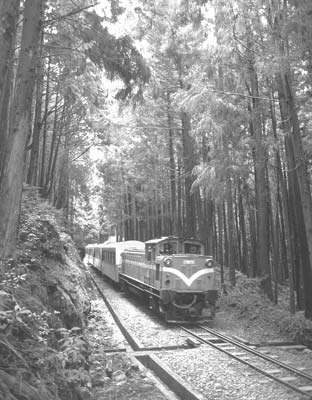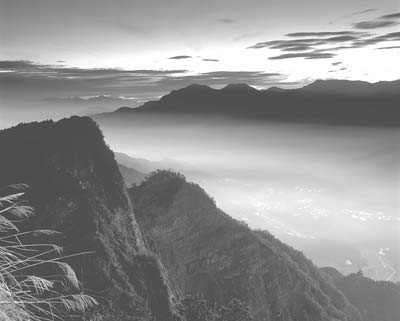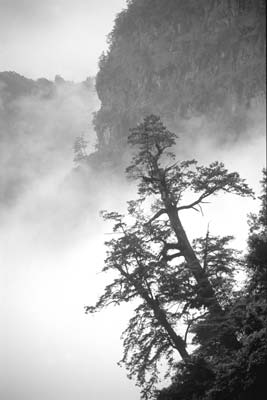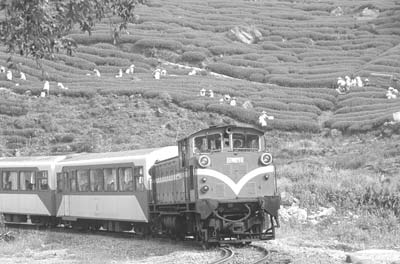A winding ride on Taiwan's remarkable forest railway
by Dennis Cavagnaro, Oakland, CA
Taiwan’s Alishan Forest Railway climbs from 30 meters at Chiayi to 2,274 meters at Alishan in just 3½ hours and gives all the adventure and spectacle any railfan could ever want. Better yet, it takes the nature lover from sea level through tropical, subtropical and temperate forests, each with its distinct flora and fauna. The railway doesn’t quite reach the frigid forest level but makes that possible for the committed hiker.
The railway
The 2½-foot-gauge railway crawls up, into and around the steep sides of Mt. Duli (Independent Mountain) by slicing through 49 tunnels, crossing 77 bridges and circling the mountain three times. The result of this engineering feat is called the “snail” because an engineer thought the twisted rails looked like a snail’s shell. As the train pops into and out of the many tunnels, passengers are amazed to look down at the railway’s tracks layered in a number of levels below.
Because of the railway’s 40-meter minimum turning radius, the passenger cars are necessarily short. Near the top of the mountain, the railway’s designers, having exhausted their bag of tricks, were forced to put in four switchbacks. The switchbacks limit the length of the trains to four coaches plus the diesel locomotive.
Heading out
Since I had a reservation (which is essential) but no ticket, I taxied to the Alishan Forest Railway’s Peimen Station to purchase my ticket before traveling 1.4 kilometers west to the mainline Chiayi Station, where the tiny train shares Platform 1 with the big boys. (Unfortunately, the railway does not have any facilities at Chiayi other than the rails.)
Not only are the ticketing facilities located in Peimen Station, the walls are covered with photos and artwork of the railway, and an HO-gauge electric model train is displayed behind glass.
We boarded the tiny cars of our train and took our seats. The forward-looking seats, two on one side and one on the other, rotated at Alishan for the trip down.
On the morning Sunrise Train, the seats are longitudinal with overhead straps for the standees. Both types of cars have huge windows for viewing.
The diesel locomotive that pushed us and our train was controlled from the lead passenger car by the engineer. We slipped the bonds of the city and headed up through a rich agricultural valley, passing bamboo groves, bright clumps of bougainvillea, pineapple fields, betel palms and tobacco fields. At the 5-kilometer marker, we passed under a freeway and began to climb.
A lush landscape
We traveled through orchards of mangoes, guavas, kiwi fruit, papayas, grapefruit and banana trees, terraced green rice paddies, taro fields and elaborate bird houses on stilts for racing pigeons.
After stopping at Chuchi (Zhuqi) Station, we crossed the river and began a serious climb. The train started making frequent turns in one direction and then the other — great for photographs (had my camera not broken). The roadbed was so well maintained that the train’s wheels very seldom squealed.
Cultivation gave way to the rainforest jungle. We entered the first tunnel and I was astonished by its facing in classical Greek temple style. I started to count the tunnels but soon gave up.
After passing through the fourth or fifth tunnel, we could look down and see the tracks we’d already passed. We were gaining altitude by crawling up the “snail.”
We came up on an area of tea plantations growing the famed oolong (Black Dragon) tea. With longer arms, we could have picked tea from the train. Farther on, we could have picked fruit as well as we passed plum and cherry orchards.
Continuing to Alishan
We reached the halfway point at the Chiao-Li-Ping (Jiaoliping) Station a few minutes ahead of the train coming down. While waiting for it to pass so we could continue our journey to Alishan, we raced over to the trackside store to purchase snacks and drinks.
Reboarding our train, we soon lumbered into the Fen-Chi-Hu (Fenqihu) Station, where little old ladies from the town raced through the train selling boxed lunches (literally in wooden boxes).
As we climbed the forested slopes, we passed through a cloud layer and it got cooler. Since most of the cedar and cypress on the mountain had been logged in the early 20th century, then replanted and logged again, we were seeing the third growth.
As we continued on, I marveled at the railway’s engineering and construction. It was as if there was no obstacle that couldn’t be tunneled through.
We had exhausted all the tunnels by the 62-kilometer post, where we ran into, and almost immediately backed out of, our first of four switchbacks. After the second switchback we were in thick forest. Soon we climbed into Alishan Station, where most passengers alighted.
In the railway’s logging days, the rails ended at Alishan. With logging gone, the forest administration recognized the railway’s recreational and tourist potential, so in 1985 two additional lines were constructed along and across high ridgelines.
One, the Mianyue Line, takes visitors to Monkey Rock, an unusual geological formation. Alas, a recent earthquake knocked off the monkey’s “head” and damaged the railway branch, which was under repair at the time of my visit in February ’03.
The other line, the Zhushan Line, takes two trainloads — nine cars each — to Zhushan (Blessed Mountain), at 2,489 meters, before daylight so that the passengers can view the dramatic sunrise above the Sea of Clouds along the Mt. Jade Range. The exact location and time of the sunrise varies during the year. Zhushan lies directly on the Tropic of Cancer, as does Chiayi.
At Alishan Station we reversed direction on our fourth switchback and climbed a bit farther, passing the border of the Alishan Forest Recreation Area and continuing through the Plum Garden to our terminus at Zhaoping Station, which hosts the yard for the Zhushan Railway cars.
A driver from our hotel, the charming Alishan House (16 West Alishan, Hsianglin Village, Taiwan; phone [05] 267-9811 or fax [05] 267-9596) that had been favored by the late president Chiang Kai-shek, met us at the station.
The particulars
The future of the Alishan Forest Railway looks good. In February ’03 the railway had more than a dozen improvement projects underway, improving tunnel facings, concreting culverts and streams and rebuilding bridges. The projects will mitigate the fury of future typhoons and earthquakes and permit expanded rail service for an expected growth in mainland Chinese ridership.
Currently, there are two trains daily in each direction: a morning (ordinary) and an afternoon (express). On holidays this expands to three, and often groups will charter extra trains. The timetable is listed in the Thomas Cook Overseas Timetable (TCOT) No. 7801.
From Taipei, take one of the frequent and fast TGV-look-alike Tsu Chiang trains between Taipei and Kaoshung (9 a.m. departure recommended). After a little more than three hours, alight at Chaiyi, have lunch and then take a taxi to Peimen Station to purchase your ticket as there is no ticket office at Chaiyi Station, where the train leaves from Platform 1.
For more information on the railway, contact the Alishan Forest Railway (Chaiyi Peimen Station; phone [05] 276-8094).
For information on Taiwan, formally known as the Republic of China, contact the Taiwan Visitors Association (555 Montgomery St., Ste. 505, San Francisco, CA 94111; phone 415/989-8677, fax 415/ 989-7242, e-mail info@visittaiwan.org or visit www.tbroc.gov.tw). Other North American offices can be found in Los Angeles, New York and Toronto.
Taiwan’s flag carrier, China Airlines, flies nonstop daily from Los Angeles and San Francisco to Taipei.





